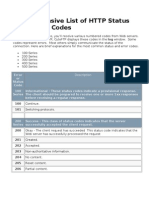HTTP 500 Series Status Codes
500 Internal Server Error
This status code is a catch-all for unexpected server errors. It indicates that the server encountered
an unexpected condition that prevented it from fulfilling the request. The exact cause of the error is
not specified in the response, making it a generic error message.
Example:
Scenario: Imagine you are using an online banking application. You have logged in successfully,
and now you want to transfer money to a friend. You fill out the form with the necessary details and
hit the 'Transfer' button. Instead of processing the transaction, the application shows a '500 Internal
Server Error' message.
Cause:
Cause: This could be due to several reasons, such as a bug in the application code, an issue with
the server configuration, or a problem with the database connection. For instance, if the code that
processes the transaction has a programming error or if the database server is down, the web
server might not be able to complete your request, resulting in this error.
501 Not Implemented
This status code indicates that the server does not recognize the request method or lacks the ability
to fulfill it. This is typically used when the server does not support a particular functionality required
to handle the request.
Example:
Scenario: Suppose you are using a RESTful API to manage your online store inventory. You send a
request using a new HTTP method called 'PATCH' to update part of the inventory data.
Cause:
Cause: If the server you are communicating with has not been programmed to handle the PATCH
�method, it will return a 501 Not Implemented error. The server might only support GET, POST, PUT,
and DELETE methods, and hence does not understand or implement the PATCH method.
502 Bad Gateway
This status code means that a server, while acting as a gateway or proxy, received an invalid
response from an inbound server it accessed while attempting to fulfill the request.
Example:
Scenario: You are trying to access a news website. The website's server needs to fetch the latest
news articles from another server (an upstream server).
Cause:
Cause: If the upstream server is down or returns a corrupted response, the main server cannot
retrieve the necessary data and responds with a 502 Bad Gateway error. This typically happens in
complex server architectures where one server relies on another to get the required information.
503 Service Unavailable
This status code indicates that the server is currently unable to handle the request due to a
temporary overload or scheduled maintenance. It suggests that the problem is temporary and may
be resolved soon.
Example:
Scenario: A popular e-commerce website announces a flash sale. As the sale goes live, thousands
of users try to access the website simultaneously.
Cause:
Cause: The sudden surge in traffic overwhelms the server, which cannot handle the volume of
requests, leading to a 503 Service Unavailable error. Alternatively, if the website administrators are
performing maintenance, they might take the server offline temporarily, resulting in this error.
�504 Gateway Timeout
This status code indicates that a server acting as a gateway or proxy did not receive a timely
response from the upstream server specified by the URI (Uniform Resource Identifier). It essentially
means that the upstream server took too long to respond.
Example:
Scenario: You are using an online travel booking site to book a flight. The site needs to check
availability with the airline's server.
Cause:
Cause: If the airline's server takes too long to respond, the booking site's server might time out while
waiting for the response, resulting in a 504 Gateway Timeout error. This usually occurs in distributed
systems where one service depends on another for data.
505 HTTP Version Not Supported
This status code means that the server does not support the HTTP protocol version used in the
request. This can happen if the client uses an outdated or unsupported version of HTTP.
Example:
Scenario: You are using an old web browser to access a modern web application.
Cause:
Cause: If your browser sends a request using HTTP/1.0, but the server only supports HTTP/1.1 or
HTTP/2, it will respond with a 505 HTTP Version Not Supported error. This indicates that the server
is configured to handle only certain versions of the HTTP protocol and does not recognize or
support the one used by the client.































































































